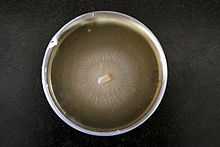Ophiostoma ulmi
| Ophiostoma ulmi | |
|---|---|
 | |
| Scientific classification | |
| Kingdom: | Fungi |
| Subdivision: | Pezizomycotina |
| Class: | Sordariomycetes |
| Order: | Ophiostomatales |
| Family: | Ophiostomataceae |
| Genus: | Ophiostoma |
| Species: | O. ulmi |
| Binomial name | |
| Ophiostoma ulmi (Buisman) Melin & Nannf. (1934) | |
| Synonyms[1] | |
|
Graphium ulmi M.B.Schwarz (1922)
| |
Ophiostoma ulmi is a species of fungus in the Ophiostomataceae family. It is one of the causative agents of Dutch elm disease. It was first described under the name Graphium ulmi,[2] and later transferred to the genus Ophiostoma.[3]
American elm
The American elm grows to be a big, gracefully shaped and beautiful vase-like tree that exists naturally mixed with other hardwoods throughout eastern North American forests and extending into the Great Plains. The elm was soon adopted by early homeowners and town settlers in North America and beautified many a street by being planted in rows on both sides of the street. Then, in 1930, a few elm trees in Cleveland, Ohio, began to show wilting, yellowing, and then browning of the leaves of some branches. The wilted, brown leaves later fell off and the branch appeared defoliated and dead. More branches showed similar symptoms later that year or the following year, and the entire elm tree usually died within 1 or a few years. Trees with similar symptoms were soon observed in some east coast states. The disease became known as Dutch elm disease because, although it had been reported from France in 1917, it was the first report from Holland in 1921 that received all the publicity. The Dutch elm disease spread rapidly in North America, crossing the Mississippi River by 1956 and reaching the Pacific coast states by 1973. In its path, the disease has killed the vast majority of yard, park, and street trees, although quite a few trees in their natural forest habitat are still free of the disease. Dutch elm disease is caused by the fungus Ophiostoma ulmi. The fungus is carried to healthy elm trees by two elm bark beetles that lay their eggs in weakened or dead elm trees or logs, often those killed by the Dutch elm disease. The eggs hatch and produce larvae that form tunnels, and if the tree or logs are infected with the disease, the fungus grows into and produces spores in the tunnels. The adult beetles then emerge covered with spores of the fungus and look for vigorous young elm branches to feed on. While they are feeding and causing hardly any damage to the elm trees, they deposit spores of the fungus in the feeding wound. The spores germinate and produce mycelium and more spores, both of which spread and multiply in the xylem vessels of the tree and cause the vessels to become clogged. Water and minerals cannot move from the root to the shoots and leaves beyond the point of clogging. The shoots and leaves subsequently wilt and die and, eventually, the entire tree dies.
References
- ↑ "Ophiostoma ulmi (Buisman) Melin & Nannf. 1934". MycoBank. International Mycological Association. Retrieved 2011-02-21.
- ↑ Schwarz MB. (1922). "Das Zweigsterben der Ulmen, Trauerweiden und Pfirsichbäume: eine vergleichend-pathologische Studie". Mededelingen Phytopathologisch Laboratorium 'Willie Commelin Scholten' (in German) 5: 1–74.
- ↑ Melin E, Nannfeldt JA. (1934). "Researches into the Blueing of ground wood-pulp". Researches into the Blueing of ground wood-pulp 32: 397–616.